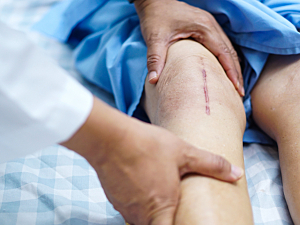Arthrofibrosis is a common complication of total knee arthroplasty (TKA). Physical therapy is the cornerstone of management, but many patients undergo either manipulation under anesthesia (MUA) or arthroscopic lysis of adhesions (ALA).
Few studies have compared these procedures because indications are usually based on temporal factors—patients with arthrofibrosis six to 12 weeks postoperatively generally undergo MUA, while patients presenting later usually have ALA for debridement of intra-articular fibrous bands.
Nathan P. Thomas, MD, PhD, a resident in the Department of Orthopaedic Surgery in the Harvard Combined Orthopaedic Residency, Antonia F. Chen, MD, MBA, director of research for the Division of Adult Reconstruction and Total Joint Arthroplasty in the Department of Orthopaedic Surgery at Brigham and Women’s Hospital, and colleagues compared MUA and ALA in the largest cohort in current literature. In the Journal of the American Academy of Orthopaedic Surgeons, they report an equivalent range of motion after ALA, early MUA, and delayed MUA, but a high infection rate after ALA.
Methods
The multicenter study included 425 consecutive adults who underwent primary, unilateral TKA between 2001 and 2018 and subsequently underwent ALA (n=211) or MUA (n=214) with a minimum follow-up of two years. The timing and selection of surgical interventions were at the surgeon’s discretion.
Complication Rates
The primary outcome was two-year complication rates:
- Overall—18% with ALA vs. 9.8% with MUA (P=0.015)
- Repeat arthrofibrosis—Similar between groups
- Revision TKA—Similar between groups
- Surgical site infection—3.8% with ALA vs. 0.47% with MUA (P=0.017)
The risk of needing a second ALA or MUA was similar between groups.
Range of Motion
The secondary outcome was range of motion (ROM) two years after ALA or MUA. There were no significant differences between the groups in flexion or extension immediately after surgery, at one year, or at two years.
Gains in flexion after MUA declined over time, while ROM outcomes for ALA were consistent. Patients with borderline ROM after MUA may be at higher risk of recurrent stiffness.
ROM outcomes were equivalent between the 129 patients who underwent early MUA (performed within three months of the index TKA) and those with more delayed MUA.
Predictors of Complications
The risk of arthrofibrosis and revision TKA was not statistically different between ALA and MUA, but infection was strongly associated with ALA (P=0.017).
The Charlson Comorbidity Index was significantly associated with the overall risk of treatment failure, implying overall health status rather than specific comorbidities predicts complications.
Conclusions
Because of the higher infection rate after ALA, MUA may be the preferred option for treating arthrofibrosis after TKA. In line with previous studies, these results show MUA remains a powerful tool for treating arthrofibrosis outside the traditional three-month window after the index TKA.
